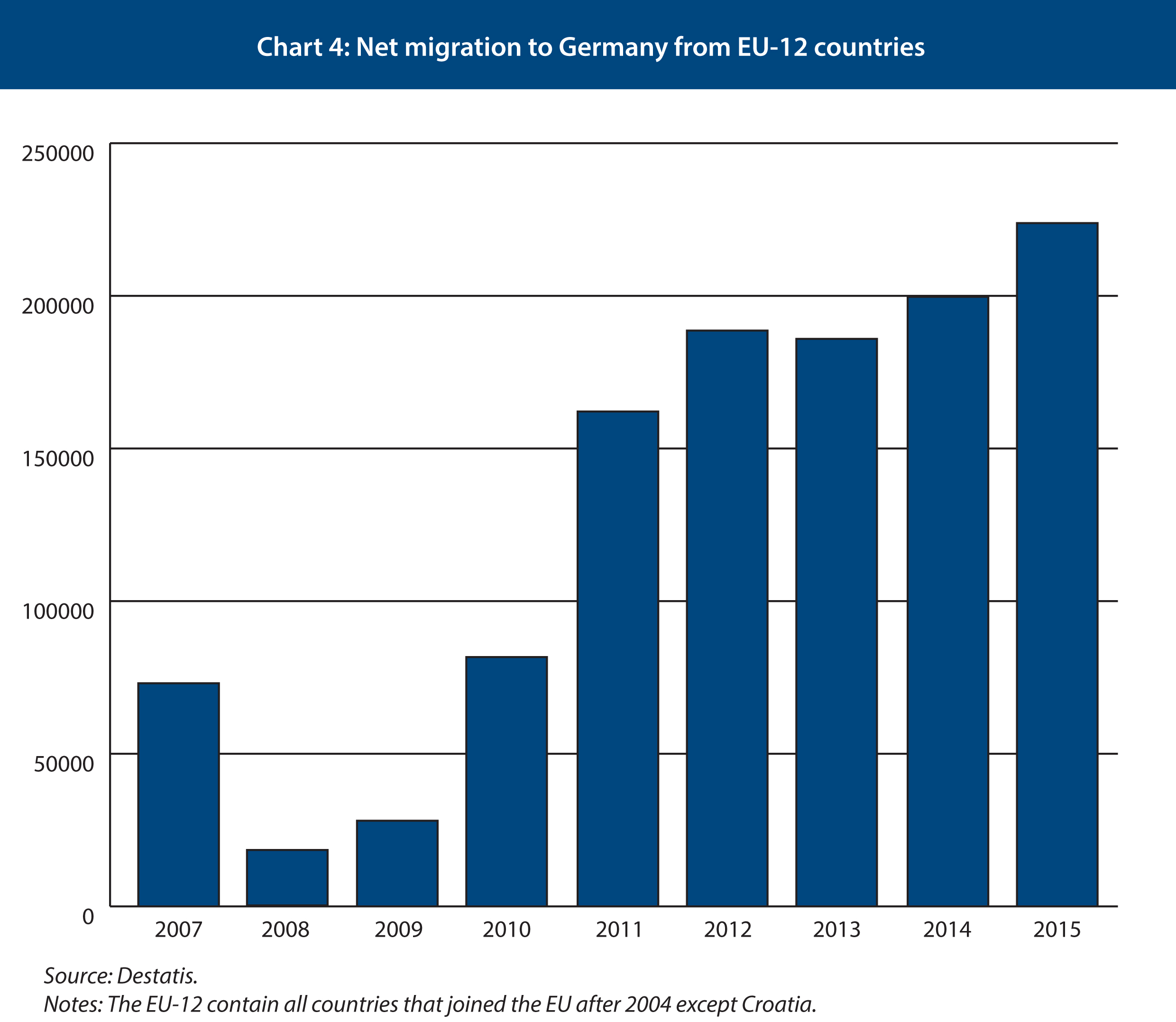
The biggest Brexit boon for Germany? Migration
Germany's economy desperately needs qualified immigrants to fill 780,000 jobs. Brexit will help it to do so.
Germany has little to gain from Brexit. The British economy is a large export market for German businesses. Britain, like Germany, is a big net payer into the EU budget. And the EU – Germany's most important geopolitical project – will lose one of its largest, most outward-looking and (somewhat) richer member-states. It is true that Frankfurt will benefit as City of London financial institutions move operations into the EU. But the biggest gain for Germany will come if European migrants choose to work there, mitigating its growing shortage of workers, instead of in Britain.
Germany’s population is not just ageing but old. The median age is now 47 (compared with 40 in the UK and 38 in the US). But demographic change has only recently started to bite economically. The cohort born around 1945 is – for obvious reasons – the smallest in the German population (see Chart 1). These are the people who retired around 2010. Unlike in other countries, the cohorts retiring now are just the start of the 'baby boomers'.

At the same time, Germany is enjoying a growth spurt. German companies are running at 86.7 per cent of total capacity, a fairly high value by historical standards. Economic sentiment is at record highs, with the widely-followed 'IFO Index' at its highest level since 1969, according to calculations by Frederik Ducrozet of Pictet. This boom is likely to last: monetary policy continues to be set to stimulate the eurozone as a whole, where inflation is lower and unemployment higher than in Germany. And the next German government will have a €30-60 billion surplus to spend, adding further economic stimulus.
The inevitable result of booming businesses and retiring baby boomers is an increasing shortage of workers with the right skills. In the European Commission's regular economic survey, almost 20 per cent of firms say that a shortage of labour is currently limiting their production – the highest value ever recorded (see Chart 2). Job openings, of which there are currently a record 780,000, have also been difficult to fill in some key professions, such as engineering, software and healthcare (see Chart 3).


Trade unions are adding to the shortage. The metalworkers' union IG Metall, which sets trends in pay bargaining in other sectors, asked for a working-time reduction for those with young children or elderly parents at home, rather than using the tight labour market to press for hefty wage increases. Employers have roundly rejected IG Metall’s demand, arguing that it would lead to working time losses equivalent to 200,000 full-time workers. Remarkably, they would rather pay higher wages; and the result of the standoff may well be the first comprehensive strike in the sector in 15 years.
There are two ways to tackle the shortage of workers. First, companies could make better use of existing workers, by offering more hours to part-time workers who want them, by retraining and helping people to relocate to find employment, or by investment into automation. Second, Germany could try to attract more qualified migrants from abroad to fill the jobs.
Attracting migrants is not simple. In theory, migrating to Germany is not difficult for highly-educated workers from outside the EU, as Germany has loosened its immigration laws considerably. Anyone with a university degree and the means to support themselves can come to Germany in search of work. Immigration from outside the EU is also relatively straightforward for people who have completed apprenticeship-type training for positions defined as ‘worker shortage jobs’ by Germany’s state employment agency.
But in practice, attracting migrants from outside the EU is proving difficult. Until recently, Germany has not been a magnet for skilled immigrants, unlike Canada or the UK. As late as the early 2000s, Angela Merkel's CDU/CSU baulked at the suggestion that Germany should call itself a ‘country of immigration’. (This was a remarkable feat of self-delusion, considering that 18.5 million people in Germany have at least one parent without German citizenship.) Moreover, the German language is not widely spoken outside the country, German culture is not particularly open to foreigners, and many bureaucratic hurdles for immigrants – like a plethora of professional qualifications – remain in place. The result is that Germany, despite its considerable efforts, managed to attract a mere 40,000 ‘qualified’ workers (those with a degree, or an apprenticeship in shortage occupations) from outside the EU in 2016.
That leaves EU citizens moving to Germany. But even here, Germany has not been the favoured destination until recently. Between 2004 and 2012, the number of EU-15 citizens living in Germany barely changed at all. Between 2012 and 2015 (the latest available data) the number from these countries increased by 200,000, mostly because of the economic crisis elsewhere in the eurozone. With the eurozone in recovery, it is unlikely that immigration from Western Europe will increase much.
The largest potential growth is from those EU countries that joined in or after 2004 (the so-called EU-12). Germany's economy was weak at that time, and the government imposed transitional controls: workers from most new member-states did not enjoy full freedom of movement to Germany until 2011, and Bulgarians and Romanians had to wait until 2014. In the five years to 2009, migration from these countries to Germany barely rose (by 200,000), only to surge by 1.1 million in the years since (see Chart 4).

But there are only so many EU-12 citizens with suitable qualifications who are willing to move. What is more, unemployment in Central and Eastern Europe is also low and firms are reporting problems hiring qualified staff. This shortage has become increasingly severe in the last two years, with a whopping 80 per cent of Hungarian companies saying that labour shortages are currently limiting their production (see Chart 5), four times as many as in Germany. An increasing number of people from Ukraine – 500,000 in 2016 alone – are moving to Poland; not as refugees, as the Polish government likes to claim, but to fill job vacancies.

As a result, migration from EU-8 countries (the Baltic countries, Czech Republic, Hungary, Poland, Slovakia and Slovenia) to the West has already peaked, despite a record number of job openings in Germany. Total net emigration from those eight countries fell from close to 200,000 at the start of the decade to less than 50,000 in 2015 (according to the latest available data, see Chart 6). The pool of internationally mobile and qualified workers in Europe, which Germany is competing for, is shrinking.

Britain’s decision to leave the EU, thanks in part to the country’s increasing hostility to immigration from Central and Eastern Europe, has handed Germany an opportunity to bring in young, often highly-educated, workers in the future. After 2004, the UK was the most popular destination for migrants from the former Eastern Bloc, thanks to the ease with which its labour market creates jobs, the English language, the attractions of London and the Labour government’s decision not to impose transitional controls on free movement, together with Sweden and Ireland. After the eurozone crisis began in 2010, the British economy (and, depending on your point of view, its society) benefitted from a second surge of immigration of workers who were struggling to find jobs in Spain, Italy, Ireland and elsewhere. (See Chart 7.)

After the referendum, net migration of EU citizens to Britain fell sharply. The biggest drop – almost to zero – was from the member-states that joined in 2004. This is unsurprising, given the debate about free movement in the campaign, and the hostility, occasionally violent, towards Central and Eastern Europeans displayed by some Britons before and after the referendum. The devaluation of sterling after the vote also means that a job in Britain is less tempting than it used to be. And Theresa May’s decision not to guarantee unconditionally the rights of EU citizens living in the UK after Brexit contributed to the inhospitable atmosphere.
With Britain’s attractions dimming, Germany is set to gain the most from the movement of labour from other EU member-states, especially from Bulgaria and Romania, and from EU citizens leaving Britain. Chart 8 shows the proportion of workers from the EU-15, EU-8 and Romania and Bulgaria (EU-2) that work in different sectors of the British economy. Western Europeans disproportionately work in banking and finance, and for the British public sector; Frankfurt’s banks will have the opportunity to employ many thousands of highly skilled workers. The same goes for German hospitals and care homes – given the country’s demographics, these workers will be valuable. Central and Eastern Europeans work in similar proportions to British citizens in all sectors bar the public sector, where fewer are employed – and in manufacturing, construction and distribution, hotels and restaurants, where more are employed.

EU migrants in Britain are also comparatively young, highly-educated workers. According to the most recent data from the UK’s Labour Force Survey, people from the newer EU member-states living in Britain are about as well-educated as the UK population as a whole, with about a quarter educated to degree-level. Nearly one in two migrants from the EU-15 hold undergraduate or postgraduate degrees. And as Chart 9 shows, EU citizens in Britain are younger than the British-born population – much younger in the case of people from the newer member-states. Since EU citizens have high employment rates, Germany has the opportunity to bring in large numbers of taxpayers, who will be net contributors to the public finances for several decades, as they have been in the UK.

With its comparatively old population, retiring baby boomers and a growing economy, Germany has the most to gain as Brexit changes patterns of migration within the EU. Germany's labour market and immigration laws have become much more flexible since the early 2000s, which will help to integrate newcomers. Germany looks set to bring in many more young, mobile Europeans, who, having been denied the franchise in the Brexit referendum, are voting with their feet.
Christian Odendahl is chief economist and John Springford is director of research at the Centre for European Reform.


Add new comment